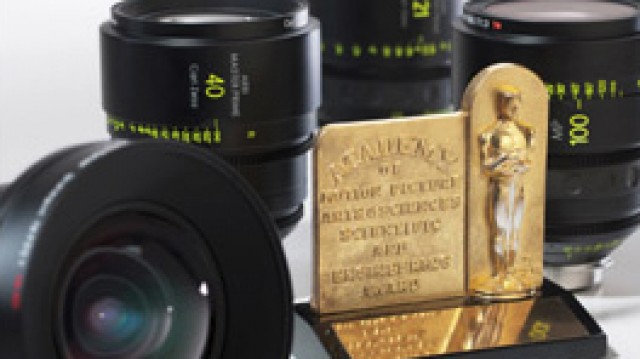Carl Zeiss design engineer Uwe Weber and his late colleague Dr. Jürgen Noffke have been honoured with the Scientific and Engineering Award® (Academy Plaque®) of the Academy of Motion Picture Arts and Sciences (©A.M.P.A.S.®) for the mechanical and optical design of the Master Prime cine lenses.
The prestigious “Technical Oscar®” was awarded to two Carl Zeiss engineers during a festive ceremony on 11 February in Los Angeles. Carl Zeiss design engineer Uwe Weber and his late colleague Dr. Jürgen Noffke, who passed away in 2011, have been honoured with the Scientific and Engineering Award® (Academy Plaque®) of the Academy of Motion Picture Arts and Sciences (©A.M.P.A.S.®) for the mechanical and optical design of the Master Prime cine lenses, a joint development by Carl Zeiss and camera manufacturer ARRI. Since 1931, the ©A.M.P.A.S.® has conferred the Scientific and Engineering Award® on companies and individuals that have made an outstanding contribution to the process of making motion pictures. The Sci-Tech Awards are presented each year, along with the well-known Oscars® for acting and film direction.
“Carl Zeiss stands for exceptional lenses and exceptional images. Our aim is to open up completely new creative possibilities for filmmakers with our lenses. We are delighted that this aim has been honoured by the award for our Master Prime lenses,” said Dr. Winfried Scherle, Vice President and General Manager of the Camera Lens Division of Carl Zeiss.
“For more than 70 years, we have been working with Carl Zeiss to develop and manufacture cine lenses,” said Franz Kraus, member of the ARRI Board of Management. “The vibrant exchange of experiences between our two companies and our customers allows us to develop exceptional products, such as the Master Prime lenses.”
Michael Ballhaus, one of the most highly regarded German cinematographers said: “The Master Prime lenses are the perfect tool for me. They open up even more creative ways to do my work. Using the Master Prime lenses I even had the opportunity to shoot a car chase in the middle of the night. No extra lighting was needed and the images had so much more contrast and much less flare.”
The experience of many successful cine lenses has gone into the development of Master Prime lenses. Numerous Oscar®-winning movies have been shot with ZEISS lenses, including the legendary “The Lord of the Rings” trilogy, which won a total of 17 Oscars®.
The Master Prime family of lenses has set new standards in cinematography. The lenses combine an extremely high speed with outstanding image sharpness, perfect contrast, and color fidelity. With these qualities, the lenses ensure that the mood created on the set is transferred realistically to the screen, regardless of whether for an action scene or the subtle facial expression of an actor shown in close-up. Scenes that are difficult to illuminate, such as a city by night, can also be realized with the Master Prime lenses. Accordingly, these lenses open up completely new creative possibilities for the cameraman and director, resulting in a highly appealing experience for moviegoers. The precision optics that are used in film production must also be able to withstand the harshest of conditions, such as heat, cold, vibrations, shocks, sand, rain, snow, smoke, and dust. The robust ARRI/ZEISS Master Prime lenses were the first fast lenses to feature outstanding optical performance at wide-open apertures. For this reason, they are used around the globe for numerous top-rated motion pictures, including the Oscar®-winning films “The Social Network”, “The Fighter”, and “The King’s Speech.” With the right focal length for any situation, ZEISS cine lenses can cover almost any angle of view used on a professional set, making them the most comprehensive lens range on the market.
Carl Zeiss and ARRI jointly introduced the Master Prime lenses in 2004 for the ARRI cine cameras. They are built by Carl Zeiss and marketed by ARRI.
This is the third time that Carl Zeiss has received the ©A.M.P.A.S.® Scientific and Engineering Award. In 1999, they received the award for the concept and optical design of zoom lenses (Variable Prime) with a performance equivalent to that of fixed focal length lenses, and it received the award in 1987 for the design and development of extremely high-speed lenses (Super Speeds).




